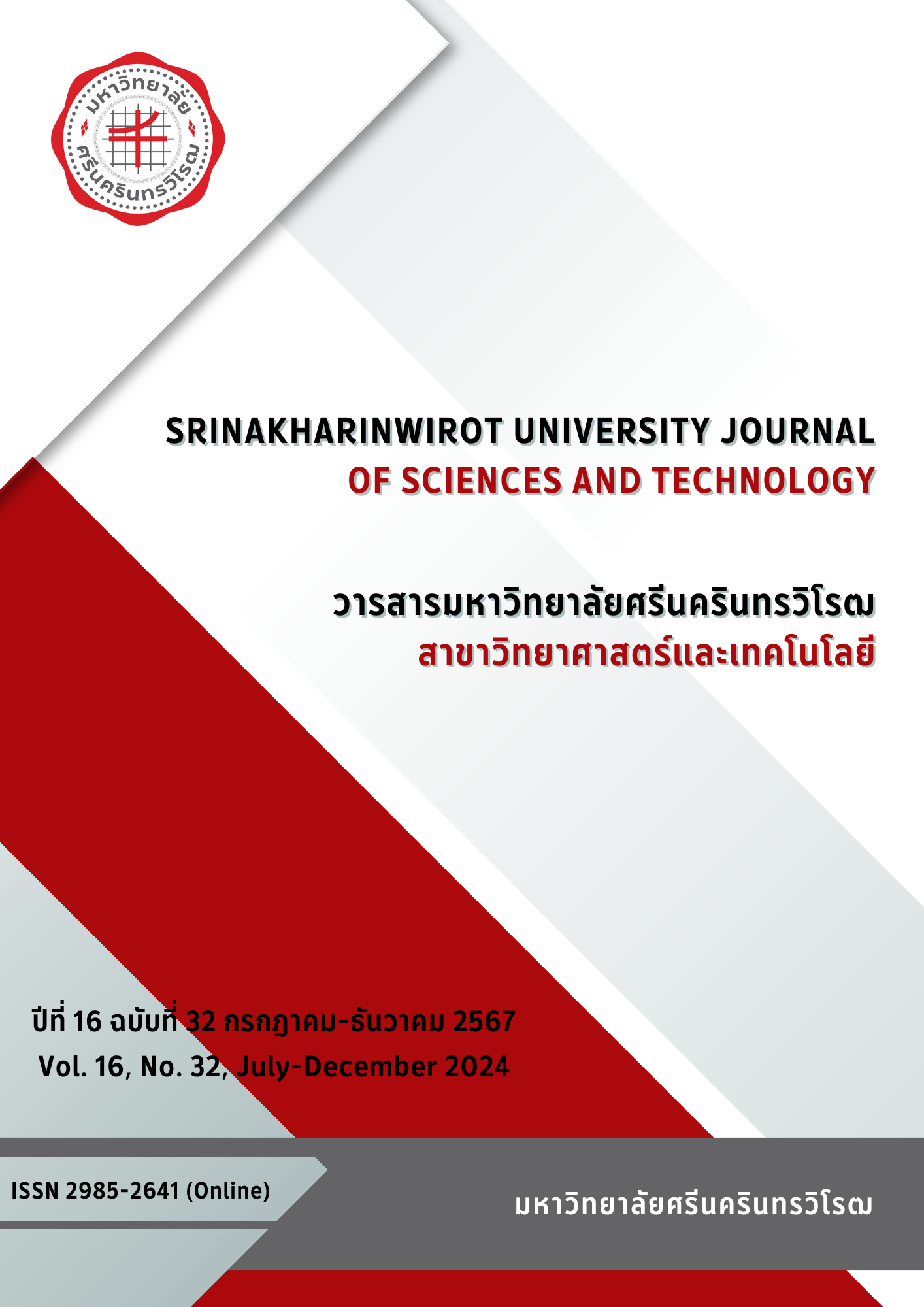WATER RESOURCES QUALITY ASSESSMENT USING BENTHIC MACROFAUNA BY COMMUNITY PARTICIPATORY: A CASE STUDY OF SAKLEEWITTHAYA SCHOOL, SENA DISTRICT, AYUTTHAYA PROVINCE
Keywords:
Benthic Macrofauna, Biological Index, Water Quality, Ayutthaya ProvinceAbstract
The study of benthic macrofauna in the Sakleewitthaya School, Sam Tum Subdistrict, Sena District, Ayutthaya Province, with community participation, aims to adapt the BMWPthai score (Biological Monitoring Working Party) and ASTPthai (Average score Per Taxa) biological indices to assess water quality. Samples of benthic fauna were collected from four stations in August 2022. The study revealed 17 species belonging to 16 families of benthic fauna from six major groups, including roundworms (nematodes), aquatic oligochaetes, gastropods, bivalves, crustaceans, and aquatic insects. Aquatic insects were the most diverse species, followed by gastropods and crustaceans, respectively. The red-rimmed melania, Melanoides tuberculate (family Thaiaridae), the Asian glass shrimp, Macrobrachium lanchesteri (family Palaemonidae), and river snails, Filopaludina martensi (family Viviparidae), were abundant. The BMWPthai score and ASTPthai revealed that the overall water quality was categorized as "satisfactory" or "moderate" in surface water quality standards class 3, with ASTPTthai scores ranging from 4.30 to 5.88. This research was conducted collaboratively with the community, aiming to enable the community to use the benthic fauna-based water quality monitoring method to track changes in water quality within their community effectively. It a guideline for efficient and sustainable cooperation in improving water quality at local water sources.
Downloads
References
Mustow, S. E. (2002). Biological monitoring of rivers in Thailand: Use and adaptation of the BMWP score. Hydrobiologia, 479, 191-229.
Chartchumni, B., Rangsiwiwat, A., Kaewdonree, S., and Rayan, S. (2017). Species diversity of benthic macroinvertebrate and application as bioindicators of water quality in nam oun reservoir, sakon nakhon province. Burapha Science Journal, 22(3), 83-94.
Konphang, N., and Ngamsnae, P. (2024). The use of biotic indices to evaluate water quality and distribution of benthic macroinvertebrates in aun river (sakonnakorn province, thailand), carrying tilapia cage culture. http://www.agri.ubu.ac.th/mis/evaluate/assess_seminar/upload/14813.pdf
Kawubon, P., Van Bam, N., Konongboa, P., Oosai, K., Kubaha, T., and Ramarn, T. (2020). Using of invertebrate as bioindicator for water quality monitoring of pak pra canal, phattalung province. Burapha Science Journal, 25(1), 209-221.
To-orn, N. (2022). Using benthic macrofauna as biological index for water resources quality assessment in pasak river, ayutthaya province. Thai Science and Technology Journal, 30(3), 33-46.
WWF. (2017). WWF Thailand and nestlé are thrilled with sakleewitthaya school's success in the water guardian youth project year 3. https://www.wwf.or.th/?318250/Youth%20Water%20Guardian%20Project
To-orn, N. (2022). Application of aquatic oligochaetes as Indicators to assess water quality for aquaculture water resource management in Ayutthaya Province. Ayutthaya: Rajamangala University of Technology Suvarnabhumi.
Maksong, S., Dapngoen, M., Chiangthong, K., Sornpai, T., and Charoenchaichankid, T. (2019). Water quality assessment and water resource management by community participatory at ban phunamron, ban kao sub-district, muang district, kanchanaburi province. Thai Science and Technology Journal (TSTJ), 28(6), 1014-1028.
To-orn, N. (2022). Solving mysteries of water quality with benthic fauna. Ayutthaya: Rajamangala University of Technology Suvarnabhumi.
Jivalak, J., Nagachinta, A., and Piumtipmanus, M. (2007). Thai economic fresh-water clam. Technical Paper No. 8/2007 Inland Fisheries Institute, Department of Fisheries, Ministry of Agriculture and Cooperatives, Department of Fisheries.
Brinkhurst, R. O. (1971). A guide for the identification of british aquatic oligochaeta (2nd ed.). University of Toronto, Toronto: Titus Wilson & Sons LTD.
Brandt, R. A. M. (1974). The non-marine aquatic mollusca of thailand. In Archiv für Molluskenkunde. Senckenbergische Naturforschende Gesellschaft, Band 105. pp. 1-423.
Fauchald, K. (1977). The polychaete worms definitions and keys to the orders, families and genera. Los Angeles: The Natural History Museum.
Raw, J. L., Perissinotto, R., Miranda, N. A. F., and Peer, N. (2016). Diet of Melanoides tuberculata (Müller, 1774) from subtropical coastal lakes: Evidence from stable isotope (δ13C and δ15N) analyses. Limnologica, 59, 116-123.
Jawed, S. T., Al-Taher, Q. M., and Shihab, A. F. (2022). Melanoides tuberculate as bioindicator of the heavy metal contamination in water and sediment pollution of euphrates river at thi-qar province, iraq. Health Education and Health Promotion, 10(2), 247-253.
Sulaeman, D., Nurruhwati, I., Hasan, Z., and Hamdani, H. (2020). Spatial distribution of macrozoobenthos as bioindicators of organic material pollution in the citanduy river, cisayong, tasikmalaya region, west java, indonesia. Asian Journal of Fisheries and Aquatic Research, 9(1), 32-42.
Australian Freshwater Invertebrates. (2024). Naucoridae-Naucoris. https://www.mdfrc.org.au/bugguide/index.htm
Downloads
Published
How to Cite
Issue
Section
License
Copyright (c) 2024 Srinakharinwirot University Journal of Sciences and Technology

This work is licensed under a Creative Commons Attribution-NonCommercial-NoDerivatives 4.0 International License.
Srinakharinwirot University Journal of Sciences and Technology is licensed Under a Creative Commons Attribution-NonCommercial-NoDerivs 4.0 International (CC-BY-NC-ND 4.0) License, Unless Otherwise Stated. Please Read Journal Policies Page for More Information on Open Access, Copyright and Permissions.



